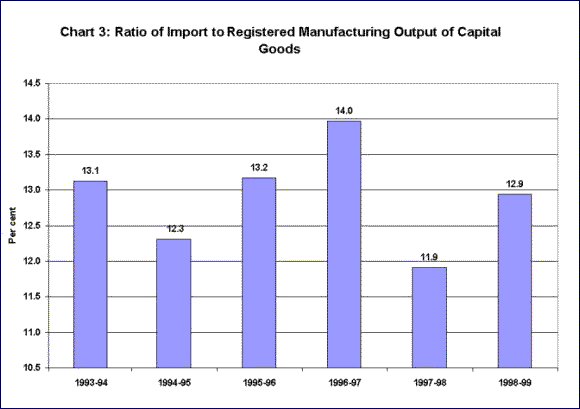India's
balance of payments position provides the principal
source of comfort for India's policy makers. Large
inflows of invisibles in 2001-02 ensured a small current
account surplus after many years, so that the large
inflows of deposits, debt and investment contributed
in the net to an accumulation of reserves that have
in recent times touched a record level of $60 billion.
While remittance, debt and investment flows have played
an important role here, there is one other factor
that has contributed to create these conditions. This
is the fact that barring the 2 years 1998-99 and 1999-2000,
India's trade deficit has been close to or well below
the levels it reached at the end of the 1980s.
As Chart 1 shows, the trade deficit which was close
to $6000 million in 1990-91, came down substantially
during the immediate post-reform years till 1993-94,
rose subseqently to around $6500 million in 1997-98,
shot up to $9170 million and $12848 million in 1998-99
and 1999-2000, and then fell to the $6000-6600 range
in 2000-01 and 2001-02.

Chart
1 >> Click
to Enlarge
This experience with the deficit during the 1990s
can be broken up into four periods of varying duration.
First, during the years 1991-92 to 1995-96, both exports
and imports grew at more or less similar rates, so
that the deficit remained low in most years and fluctuated
within the $1 billion to $5 billion range. Second,
between 1995-96 and 1998-99, while imports continued
to grow, exports stagnated resulting in a widening
of the trade deficit to $9.1 billion by the end of
that period. Third, in 1999-00, while exports recovered,
imports surged because of a rise in oil prices, resulting
in the widening of the trade deficit to $12.8 billion.
Finally, in 2000-01 and 2001-02, while exports rose
initially and then remained at that level, imports
stagnated and the trade deficit returned to the levels
it had touched in the mid-1990s.
One feature of this experience is the sharp deceleration
in export growth since 1995-96. While over the six-year
period 1989-90 to 1995-96 exports rose by 91 per cent,
the increase over the subsequent six years ending
in 2001-02 was only 38 per cent. Further, besides
some expansion in earning from exports of software
and IT-enabled services, the structure of India's
exports has not changed very much. Clearly, the dynamism
that was expected on the export front in the wake
of reform has not been realised. This implies that
whatever "gains" have been registered on
the trade front has been on account of the containment
of imports, which is indeed puzzling given the expected
consequences of import liberalisation.
Resolving this puzzle requires a closer look at the
performance of different categories of imports. It
is known that movements in oil imports, which are
influenced by oil prices, have substantially influenced
the size and direction of India's overall import bill.
Chart 2 examines, therefore, the movements in India's
non-oil trade balance. The picture that emerges is
indeed remarkable. During the period 1990-91 to 2000-01,
in all years excepting one (1998-99), India's non-oil
trade has either been in balance or reflected a surplus
of exports over imports. Further, a rise in exports
in 2000-01 and a fall in imports had taken that surplus
to $7.8 billion. This is remarkable because, barring
a couple of years, India's export growth has not been
creditable. On the other hand, import liberalisation,
involving the removal of quantitative restrictions
and reductions in tariffs, was expected to result
in a surge in non-oil imports. It is clearly because
such a surge has not occurred that India's trade deficit
has been contained in most years when oil prices were
not ruling high.

Chart
2 >> Click
to Enlarge
However, Chart 3, which traces the category-wise movements
in imports, suggests that it may be premature to arrive
at such a judgement. Movements have been quite varied
in the 4 principal categories of imports (oil, non-oil
bulk, export-related and other imports). While oil
imports have fluctuated quite significantly, as is
to be expected, and rose to relatively high levels
in 1996-97 and 1999-00 to 2000-01, export related
imports have shown a low but consistent rate of increase
since 1994-95. Non-oil bulk imports on the other hand
have stagnated till the mid-1990s, risen by a small
amount during 1995-97 and stagnated once again thereafter.
The really striking feature of the experience described
by Chart 3 is the increase in "other imports"
between 1991-92 and 1998-99, after which they have
stagnated. We must note here, that the segment of
imports most affected by liberalisation was the large
category of "other imports", which includes
most manufactured imports directed towards production
for or direct sale in the domestic market. The share
of that category, which stood at 40 per cent in 1990-91,
rose to 47 per cent in 1995-96 and 52 per cent in
1998-99, before falling to 43 per cent in 2000-01
(Chart 4).

Chart
3 >> Click
to Enlarge

Chart
4 >> Click
to Enlarge

